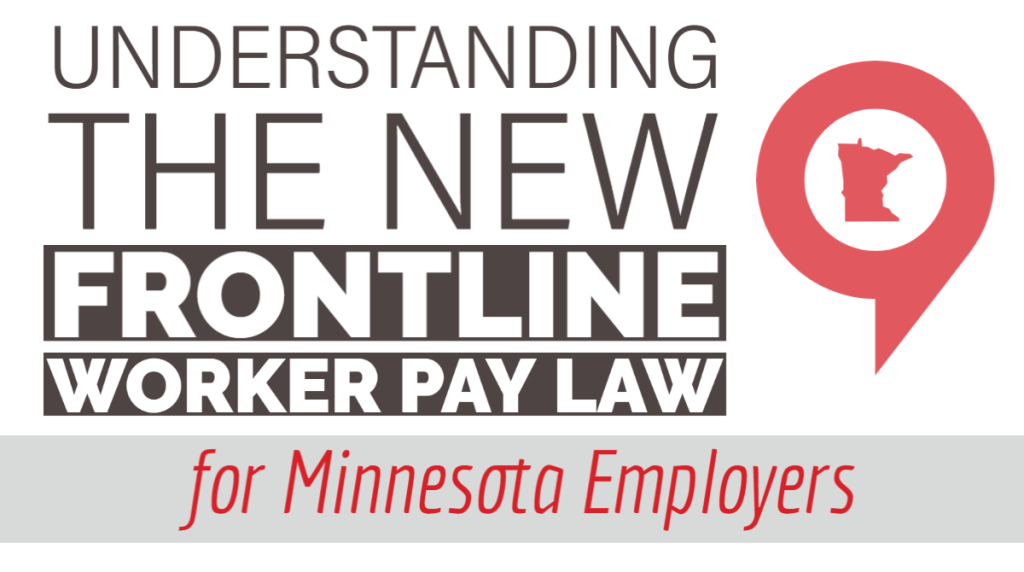
Posted June 8th, 2022 in Top Stories, Legal Insights with Tags COVID-19 for Employers, COVID-19
Minnesota Employers: Understanding the New Frontline Worker Pay Law
Minnesota Governor Tim Walz signed a bill into law last month providing bonus pay for eligible COVID-19 frontline workers. Although the State is administering the program, which opens June 8, 2022, the Frontline Worker Pay law requires that employers in a “frontline sector” provide notice to current employees who may be eligible for the payment by June 23, 2022. We have put together a few key takeaways for you to consider in evaluating potential notice obligations.
Frontline Sectors
Employers covered by the Frontline Worker Pay notice obligations are those in a “frontline sector,” which is defined to include:
- long-term care and home care;
- health care;
- emergency responders;
- public health, social service, and regulatory service;
- courts and corrections;
- child care;
- schools, including charter schools, state schools and higher education;
- food service, including production, processing, preparation, sale and delivery;
- retail, including sales, fulfillment, distribution and delivery;
- temporary shelters and hotels;
- building services, including maintenance, janitorial and security;
- public transit;
- ground and air transportation services;
- manufacturing; and
- vocational rehabilitation.
Gray Area Analysis
For some employers, whether they fall under one of these frontline sectors, and are therefore required to provide notice to employees, will be relatively straightforward. For others, not so much. The Minnesota Department of Labor and Industry (MNDLI) posted guidance providing examples of work settings within each sector; however, the guidance indicates that the lists are not exhaustive and were meant to give a general idea of the type of employment covered. Because the law itself does not provide definitions for the frontline sectors, employers questioning whether they are covered should first consult the MNDLI guidance linked above. For those “gray area” employers in work sectors not specifically listed as an example in the guidance, whether or not to move forward with providing notice will depend on risk tolerance. While the new law does not address what happens if an employer fails to provide timely notice, eligible employees who do not receive notice in time for them to apply may decide to raise the issue with their employer directly, seeking payment in the amount they would have received.
As an example, many organizations fall generally under the “health care” umbrella yet may not provide direct patient service like the entities listed as examples in the guidance, demonstrating that many health care industry employers were likely not contemplated for purposes of frontline worker pay. But these employers may still choose to provide employee notice out of caution, allowing employees to decide for themselves whether to apply.
Eligible Employees
After an employer determines they fall (or may fall) within a frontline sector, the law requires notice be provided advising all current employees “who may be eligible” for payments.
The eligibility criteria states that applicants for Frontline Worker Pay must:
- have been employed at least 120 hours in Minnesota in one of the frontline sectors listed above between March 15, 2020 and June 30, 2021; and
- for the hours worked during that timeframe, the applicant must have been unable to telework due to the nature of the individual’s work and must have worked in close proximity to people outside of the individual’s household. Regarding the close proximity component, this is likely satisfied if an employee was unable to properly social distance from coworkers or the public during the relevant timeframe.
In addition, there are limitations based on an applicant’s income and whether they received unemployment insurance benefit payments for a specified length of time. For applicants without direct COVID-19 patient care responsibilities, the adjusted gross income limit is $185,000 for married taxpayers filing jointly, or $85,000 for other filers for at least one of the 2020 or 2021 tax years. Applicants with direct COVID-19 patient care responsibilities must have had an adjusted gross income of less than $350,000 for married taxpayers filing jointly, or less than $175,000 for other filers.
Eligibility Determination
Whether individual applicants are eligible to receive the bonus payment will ultimately be determined through the application process via the MN Department of Labor and Industry, and employers are not required to independently evaluate eligibility for notice purposes. Notably, such an evaluation would be particularly difficult because the hours worked eligibility criteria is not specifically limited to hours worked for one employer but rather to employment in one of the frontline sectors generally. However, depending on the circumstances, employers may have reason not to provide notice to all current employees. A large employer, for example, may provide notice to its current employees working in retail or grocery stores, but not to corporate office employees who were fully remote during the relevant timeframe.
Required Notice by June 23, 2022
The required notice may be provided to workers in paper or an electronic format or posted in a place where it may be readily viewed by all employees. However, the means used to provide notice must be the same means used to provide any other work-related notices to employees. A compliant notice prepared by the MN Department of Labor and Industry can be found here.
As you consider how the Frontline Worker Pay law may impact your operations, please let us know if you have any questions.
